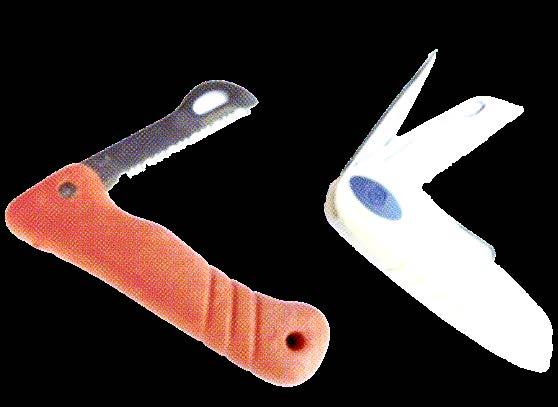
6 minute read
Safety Knives for powerboaters and sailors
為機動船員和海員而設的安全刀具
by Kevin Lewis
Advertisement
A knife is a vital piece of safety kit for safety boat drivers, crew, cruiser and dinghy sailors and instructors. However, there are many knives available so it could be difficult to know what to look for.
Blade shape There are various blade shapes fit for different purposes but for marine use, most safety knives should have a rounded or flat tip. This avoids puncturing equipment and guards against accidentally injuring yourself or another person. In rescue situations it may be that a sailor is trapped—they may be tangled in the ropes or need to cut their harness or clothing to free themselves. These types of knives can safely be placed close to the body without the risk of additional injury.
A simple floating knife is cheap and popular but often has a low-quality metal blade. The popular ‘Wishard’ knife has a sharp pointed tip. (photo needs background edited out)
Fixed-blade knives This type of knife is usually kept in a sheath and often used by divers. These are quite suitable to keep onboard. The knife should be stored in a known place that is easily accessible in case of emergency. However, it should be kept far away from children and in a dry location – which may prove challenging in a RIB! The Gill Safety knife is just one example of a knife that may be fixed in position or kept on your boat for emergency use.
刀鋒形狀 針對不同用途的刀鋒形狀各異,但 於海上使用時,大部分安全刀都有 圓或扁的刀尖。這可避免刺破用具 或意外傷及自己或他人。在救援的 情況中,有可能是航海員受困—— 他們可能被繩子纏住,或會需要剪 斷安全帶或衣服來逃生。這類型的 安全刀能安全地隨身攜帶,減低額 外受傷的風險。
一把簡單的浮刀價格便宜而大受歡 迎,但其金屬刀片通常質量不佳。 受歡迎的「Wishard」則刀尖鋒利。 (照片背景需要去掉)
直刀 這類型的刀通常保存在刀鞘內,通 常為潛水員所用。這類刀非常適合 留在船上。這種刀應存放在已知及 容易拿取的地方,以防萬一。但這 種刀亦應存放於遠離兒童及乾燥 的地方——在充氣艇上使用是具 有挑戰性的!GILL安全刀是其中一 個例子, 需要固定擺放在適當位置 或保留在船上以供緊急使用。
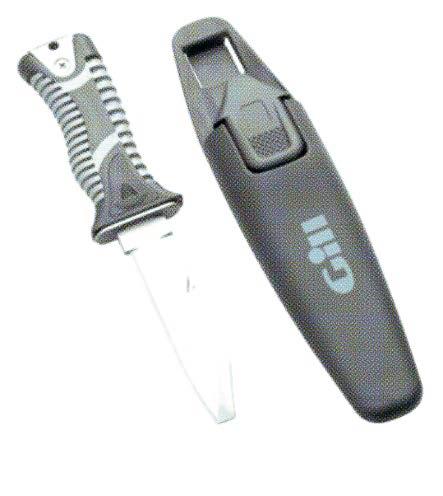
The folding personal knife Anyone involved with on-water activity at HHYC—be it, powerboat crew, instructors, or volunteers, should seriously consider having a personal safety knife that is always kept on their person. Even yacht sailors should consider such a knife as there are instances where people have fallen overboard, and the safety knife was on their boat.
One incident in Europe involved a capsized RIB; the safety kit was in a locker inaccessible once that boat was upside down. A crew member became trapped after their lifejacket inflated and they were caught under the upturned boat. Luckily, on this occasion, another crew member had a safety knife on his person and was able to use it to free the trapped crew member. A more local example involved an experienced dinghy sailor at an HK club who slid under the toe-straps as the boat capsized and became wedged in the boat as it inverted. He had his own safety knife and easily cut the strap and freed himself without much difficulty. The Gerber, Spyderco and Palm knives are all highly recommended.
摺疊式個人用小刀 任何參與 本會水上活動的人士,無論是動力船船員、教練或 義工都應該認真考慮隨身攜帶一把個人安全刀。因為曾有有 人掉進水裡、而安全刀留在船上的情況,因此即使是遊艇上 的航海員亦應該考慮使用這種刀。
歐洲發生的一宗事故涉及充氣艇翻側,安全套件則放在儲物 櫃中,一旦船隻翻側時就未能即時拿到。一名船員在被困在 翻轉的船下時,因為救生衣膨脹而被困。幸好在此次事故中, 另一名船員在身上帶住安全刀,並能夠以此為該船員解困。 另一個本地的例子是,香港遊艇會一名經驗豐富的帆船船 員,在船身翻側時被滑到船身船頭帶處,並卡於船身內。當時 他帶薯自己的安全刀,輕而易舉地割斷了船頭帶而輕易地掙 脫。強烈推薦 Gerber、Spyderco 和 Palm 的安全刀。
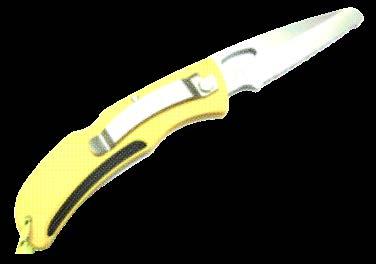
The “Gerber” E-Z Out Safety Knife is the number one recommendation and is also the safety knife recommended by the RYA. Gerber E-Z Out 安全刀是推薦的第 一位,亦是 RYA 推薦的安全刀。
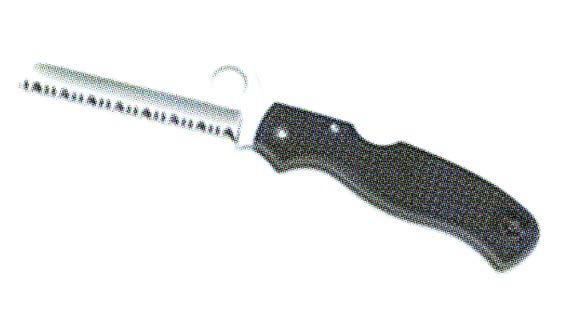
The Spyderco H-1 Atlantic Salt is a more expensive but highly recommended top-quality knife, the blade is made from non-rusting H-1 Steel. Spyderco H-1 Atlantic Salt 是一款價 格較高但受極力推薦的頂級安全刀, 刀片採用了防鏽的 H-1 鋼所製成。
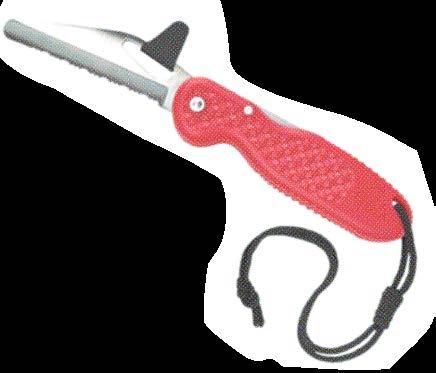
The Palm Folding Knife has been purchased by HHYC. It is of a similar design to the Gerber and Spyderco but slightly less costly. 而 Palm 摺疊刀一直為 HHYC 購買的款式。 其設計與 Gerber 和 Spyderco 類似,但價 錢較便宜。
There is a particularly obvious risk associated with high-performance dinghies—often crew members will be wearing a harness with a hook. Such boats tend to have more ropes, more complex rigging and capsizes are often faster and potentially more serious. HHYC recommends that anyone sailing with a trapeze should always carry a safety knife with them. Instructors and parents should also always carry a personal safety knife, but we do not encourage younger children to have their own knives for obvious reasons. Over the past few years, there have been several incidents in Hong Kong where safety knives have been used successfully to prevent a more serious situation from developing. The danger is real, and we should all take the opportunity to reduce such risks.
Design The design of a knife is important. It should be very firmly closed so that under no circumstances can the blade be accidentally exposed. At the same time, it must be easy to open and ideally should have a mechanism that holds the blade open while in use to avoid any risk of injury. Any knife also needs a lanyard, so it is not easily lost though beware; a knife on a cord around your neck introduces a new and significant risk of becoming tangled. Ideally, the knife should be attached to your lifejacket—buoyancy aids with pockets are ideal. Of course, some larger yacht sailors may choose not always wear a lifejacket and, in that case, a knife with a cord and clip may be kept in your pocket and clipped to your belt.
Multi-blade knives Knives come in many designs and multi-blade models provide a few extra useful functions. Of particular use to water users will be a shackle key and a marlin spike. However, the overriding consideration with a multi-blade knife must be ease of use and maintenance. A Swiss Army type multi-blade knife is not suitable for a marine environment. Too many blades may be difficult to maintain and not easy to operate in difficult conditions.
Blade materials Steel is a combination of iron and a small amount of carbon. For knives, an alloy is produced that includes various percentages of other materials that add certain properties to the knife blade. Quality blade manufacturers may blend over a dozen materials to provide specific qualities in their knives. Stainless steel contains a higher percentage of chromium which makes it more resistant to corrosion—the chromium oxide creates a barrier to oxygen and moisture, helping to reduce rust formation. Marine-grade stainless steel has the highest chromium content but is also the most expensive. Titanium is a lightweight metal that contains little or no iron and as such, it is almost completely resistant to saltwater corrosion. Though, depending on the knife it may not be as sharp as a traditional steel blade. A new type of steel—H-1, is used by some manufacturers. This type of steel replaces carbon with nitrogen and is also very highly resistant to corrosion. Teflon is sometimes used as a blade coating and is effective in reducing corrosion but can be scratched off in use.
Knife care No matter the design or material, any safety knife needs appropriate care to prevent corrosion or deterioration. The golden rule is to wash your knife in fresh water and completely dry it after it has become wet; salt water will attack even the highest quality blade. Knives kept aboard or in lifejacket pockets need to be checked and cleaned regularly. Lubricating and protective oils such as three-in-one or even WD-40, can be used, although this can be quite messy so best to apply a small amount on a cloth. The best option is newer dry-film lubricants that bond to the blade’s surface. These can be bought quite cheaply as wipe-on cloths.
高性能的帆船有一個特別明顯的風險——通常船員們都會 佩戴帶有鉤子的背帶。這類船隻往往有更多繩索和更複雜 的索具,翻倒的速度通常更快,而且可能更為嚴重。本會建 議乘坐帆船出海的任何人士一定要隨身攜帶安全刀。教練 和家長也一定要隨身攜帶個人安全刀,但眾所周知,我們 並不鼓勵年幼的子女擁有自己的安全刀。在過去幾年,本 港曾發生過數次使用安全刀而成功阻止嚴重意外的情況。 這些危險確實存在,我們都應盡力減低風險。
設計 安全刀的設計十分重要。安全刀要能非常牢固地關上,在 任何情況下都不能意外地露出刀刃。同時安全刀亦必須能 容易打開,最理想的是在使用過程中應有一個保持刀刃打 開的機關,以避免任何受傷的危險。任何一把安全刀都需 要繫繩,以免輕易遺失;如果你用繩子把安全刀繫在頸上, 則會產生另一種嚴重的纏繞風險。在理想情況下,安全刀 應該附在你的救生衣上——帶口袋的浮力輔助裝置最為理 想。當然有些較大的遊艇船員或不會經常穿上救生衣,這 時一把有繩子和夾子的安全刀可以放於口袋之中,以夾子 夾在腰帶上。
多刃刀 刀子有多款設計,多刃刀提供一些額外的實用功能。對海 員特別有用的是一把鑰匙扣和一個索針。然而,多刃刀的 首要考慮是易用性和維護。瑞士軍用多刃刀並不適合海 上環境。刀葉太多可能會很難維護,在困難的情況下亦不 易操作。
刀片物料 鋼是鐵和少量碳的混合物。對於刀具來說,使用不同比例 的其他物料產生的一種合金,能為刀刃增加某些特性。優 質刀片製造商可以混合超這個十多種物料,以確保刀片中 的特定品質。不鏽鋼中含有較高含量的鉻,令耐腐蝕性更 高——氧化鉻形成屏障阻隔氧和水分,有助於減少鐵鏽的 形成。船用不鏽鋼的鉻含量最高,但價格亦是最高。鈦是一 種輕量金屬,含少量鐵甚至不含鐵,因此幾乎能完全抵受 鹽水腐蝕。不過,根據刀子的不同,它可能不及傳統的鋼刀 鋒利。一些製造商使用一種新型的 H-1 型鋼。這種鋼以氮 取代碳,並具非常高的耐腐蝕性。鐵氟龍有時用作刀片塗 層 ,對減少腐蝕有效,但或會於使用中被刮掉。
刀片保養 不論是哪款設計或物料,任何安全刀都需要適當的保養以 防止腐蝕或破損。黃金戒律是以清水清洗安全刀,濕透後 需完全晾乾;即使是最優質的刀刃亦能受鹽水損害。保管 在船上或救生衣口袋中的刀具需要定期檢查和清洗。可以 使用潤滑油和保護油,例如三合一甚至 WD-40,這類潤滑 油可能比較容易沾污四周,最好使用布料少許塗抹。最佳 選擇是可與刀片表面結合的新式乾膜型潤滑劑。這些就像 擦布一樣可以便宜價錢買到。










